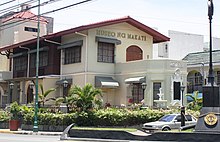Opened in 1937 by the Philippine Racing Club, it was the first notable
sport venue of Makati, and was the forerunner of other famous Makati sport venues where international competitions were held such as the Manila Golf Club, which located in Makati in 1948, the Manila Polo Club, which relocated to Makati in 1950, and the defunct
Astrobowl Magallanes. It was larger than the San Lazaro Racetrack in
Santa Cruz, Manila.
During World War II it became a military storage area, and as a consequence was targeted by aerial bombardment toward the end of the war. On 9 February 1945 it was at the Philippine Racing Club grounds that the Americans, advancing from Wack Wack golf club (
photo no. 26a) and crossing the Pasig River using
amtracs, returned to Makati. Afterward, they built a
pontoon bridge (
seventh photo) which was one of two such temporary bridges they had to build after the last remaining bridges spanning the Pasig River—Banzai (Jones) and Santa Cruz (MacArthur)—were blown on 5 February. This pontoon bridge was damaged and knocked out by artillery fire on 10 and 11 February and was reported as having been repaired (
photo). The Art-deco buildings of the racetrack were later used as a headquarters by US General MacArthur and also by
Allied translators and interpreters.
Horse racing resumed during the postcolonial period. Toward the end of the twentieth century, an increase in the taxation of winnings combined with a rise in the ownership of TV sets led to a decline in attendance, which resulted in the closure of the racetrack in December 2008 and its demolition in 2013.
Santiago Hospital[edit]
The Santiago Hospital was a twentieth-century medical facility in Población. Originally named
Hospital Español de Santiago, it was founded in 1902 in Manila by the Spanish community as an infectious hospital for the hospitalization of Spaniards who, having to comply with sanitary regulations concerning compulsory hospitalization, preferred the services of this hospital rather than those of the public San Lazaro Hospital. Its earliest known address was 1819
Calle Azcárraga, Quiapo. In 1929 the hospital moved into its own building, an Art-deco structure in Makati, and at the beginning of the thirties was one of two hospitals in Rizal Province. By 1935 this medical facility, which had thirty-four beds, was classified as a general hospital which treated all sorts of diseases except those requiring compulsory segregation in government institutions, and by that time was admitting patients of nationalities other than Spanish.
During World War II, Santiago Hospital was administered by the
Sisters of Saint Paul of Chartres, and in February 1945 it had the distinction of being the only hospital in the Greater Manila area which remained open throughout the
Battle of Manila. Santiago Hospital, which was once considered to be one of the best hospitals in the Philippines, closed in the 1960s as a result of the increasing urbanization of Makati.
Although generally believed to be Makati's first hospital, it was preceded by a hospital in Guadalupe which existed during the
First Republic. Also over a decade earlier in 1884, the Spanish briefly operated in Guadalupe an orphanage, a type of institution which in their point of view was a medical facility. In 1917, the Americans also opened an orphanage in Makati, at Casa Quinta.
Gabriela Silang Monument This monument is dedicated to the Ilocano Revolutionary Gabriela Silang. Even many miles away from Vigan, There is where the statue stands till today.
Culture and sports[edit]
Makati is home to a number of fine art museums, colonial-era churches and recreation areas. Along the south-eastern border of Makati beyond
Forbes Park are the
Manila Golf Club and the Manila Polo Club.
[35] The
Manila Golf Club features an 18-hole
golf course. The Manila Polo Club counts among its
polo enthusiasts some of the country's wealthiest people. The Makati Sports Club in Salcedo Village is another popular place for sports. The
Makati Coliseum is another famous sports landmark in the city, where some of the biggest sports gatherings are held.
The
Ayala Museum is a private fine arts and history
museum housing various exhibitions such as the "Gold of Ancestors," an exhibition of more than one thousand golden pre-Hispanic artifacts.
[36] Other popular museums also in Makati also include the Yuchengco Museum and the Museo ng Makati.
Makati has several Spanish-era churches, such as the
Our Lady of Guadalupe and the
Nuestra Señora de Gracia Church (Our Lady of Grace) in the old town. At the Greenbelt Park stands the modern domed chapel of the Sto. Niño de la Paz. Between
Forbes Park and
Dasmariñas Village is the Santuario de San Antonio, a popular church for weddings in the Makati area. The National Shrine of the Sacred Heart is located in San Antonio Village. Makati also houses the country's only
Jewish synagogue, Beth Yaacov.
[37]
According to Time.com, Makati is not only the financial center of the Philippines, but also the
selfie capital of the world.
[38]






